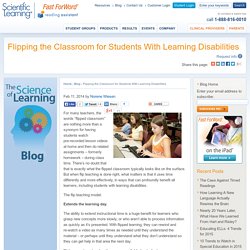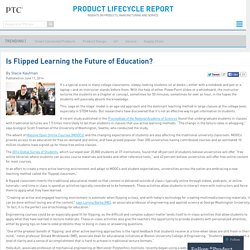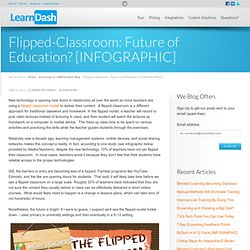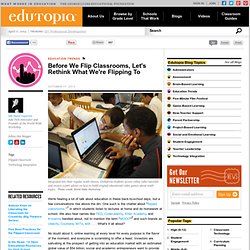

Modifying the Flipped Classroom: The "In-Class" Version. So.

You've tried flipping your class, and it didn't go well. Or you've heard about flipping and want to try the approach, but you're pretty sure it won't work in your school. Don't give up yet -- with a slight twist, flipping might be possible for you after all. Flipped classrooms -- where direct instruction happens via video at home, and "homework" takes place in class -- are all the rage right now, and for good reason. Early research on flipped learning looks promising. But successful flipping has one big catch -- if it's going to work, the at-home learning absolutely must happen.
Arranging access before and after schoolLending out devicesSending recorded lectures home on flash drives or DVDs These are all workable solutions. The Surprising Ways BYOD, Flipped Classrooms, and 1-to-1 Are Being Used in the Special Ed Classroom. Accessibility | May 2013 Digital Edition The Surprising Ways BYOD, Flipped Classrooms, and 1-to-1 Are Being Used in the Special Ed Classroom As schools shift to mobile device usage and new forms of technology-inspired instruction, such as flipping the classroom, special ed is adopting mainstream approaches for its assistive technologies.

By Dian Schaffhauser05/30/13 The latest compilation from the US Department of Education (from 2010-2011) reports that about 13 percent of public school enrollment consists of students served by special education programs. That count has pretty much stayed the same for the last 13 years. What's different now is that, as technology pervades all aspects of the classroom, special education teachers need to make a decision about whether they're going to stay on track with specialized assistive technologies or adopt some of the mainstream ones that general education students are using. The latter approach appears to be winning right now. Flipping the Classroom for Students With Learning Disabilities. For many teachers, the words “flipped classroom” are nothing more than a synonym for having students watch pre-recorded lesson videos at home and then do related assignments – formerly homework – during class time.

There’s no doubt that that is exactly what the flipped classroom typically looks like on the surface. But when flip teaching is done right, what matters is that it uses time differently and more effectively, in ways that can profoundly benefit all learners, including students with learning disabilities. The flip teaching model: Extends the learning day. The ability to extend instructional time is a huge benefit for learners who grasp new concepts more slowly, or who aren’t able to process information as quickly as it’s presented. Makes precious teacher time more available to students. With instruction now happening at home on students’ time, teachers have more time to observe students as they apply what they have learned.
Levels the playing field. Can Special Education Students Benefit From Flipped Classrooms? – Remake Learning. How special education experts are using new technologies and innovative instructional models like the flipped classroom to help their students succeed.

Is Flipped Learning the Future of Education? It’s a typical scene in many college classrooms: sleepy-looking students sit at desks—either with a notebook and pen or a laptop—and an instructor stands before them.

With the help of either PowerPoint slides or a whiteboard, the instructor lectures the students on a chapter or concept, sometimes for 50 minutes, sometimes for over an hour, in the hopes the students will passively absorb the knowledge. This ‘sage on the stage’ model is an age-old approach and the dominant teaching method in large classes at the college level, especially in STEM fields. But researchers have discovered that it’s not an effective way to get information to students. Flipped-Classroom: Future of Education? New technology is opening new doors in classrooms all over the world as more teachers are using a flipped classroom model to deliver their content.

A flipped classroom is a different approach for traditional classwork and homework. In the flipped model, a teacher will record or post video lectures instead of lecturing in class, and then student will watch the lectures as homework on a computer or mobile device. This frees up class time to be spent on various activities and practicing the skills while the teacher guides students through the exercises. Relatively new a decade ago, learning management systems, mobile devices, and social sharing networks makes this concept a reality. In fact, according to one study (see infographic below provided by WeAreTeachers), despite the new technology, 70% of teachers have not yet flipped their classroom. Still, the barriers to entry are becoming less of a hazard. Nonetheless, the future is bright. Before We Flip Classrooms, Let's Rethink What We're Flipping To. Integrated into their regular math classes, Globaloria students access online video tutorials and receive expert advice on how to build original educational video games about math topics.

Photo credit: World Wide Workshop We're hearing a lot of talk about education in these back-to-school days, but a few conversations rise above the din. One such is the chatter about "flipped classrooms,"1 in which students listen to lectures at home and do homework at school. We also hear names like TED, Codecademy, Khan Academy and Knowmia bandied about, not to mention the term "MOOC"2 and such brands as Udacity, Coursera, MITx, edX . . . What's it all about? No doubt about it, online learning at every level for every purpose is the flavor of the moment, and everyone is scrambling to offer a feast.
Instructionism vs.